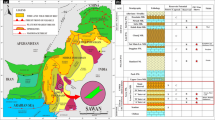Abstract
Seismic hazard assessment based on urban active faults can provide scientific bases for city planning and project construction, while numerical simulation of strong ground motion is an important method for seismic hazard prediction and assessment. A 3-D physical model in conformity with real strata configuration of (mainly) the Quaternary is a prerequisite to ensure the reliability of the simulation results. In this paper, we give a detailed account of the technical scheme and process for creating a 3-D physical model in Kunming basin. The data used are synthesized from seismogeological data, borehole data, topographic data, digital elevation mode (DEM) data, seismic exploration results and wave velocity measurements. Stratigraphic division is based mainly on shear wave velocity, with strata sequence taken into consideration. The model construction is finally accomplished with ArcGIS and many relevant programming techniques via layer-by-layer stacking (in depth direction) of the adjacent medium interfaces (meshes). Meanwhile, a database of 3-D physical models is set up, which provides model data and parameters for strong ground motion simulation. Some processing methods and significant issues are also addressed in the paper in accordance with different types of exploration and experimental data.
Similar content being viewed by others
References
China Earthquake Administration. 2005. Stipulation on technical system for China earthquake active fault surveying [M]//Specification on China Digital Seismograph Network (JSGC-04). Beijing: Seismological Press: 71–72 (in Chinese).
GAO Meng-tan, YU Yan-xiang, ZHANG Xiao-mei, et al. 2002. Three-dimensional finite-difference simulations of ground motions in the Beijing area [J]. Earthquake Research in China, 18(4): 356–364 (in Chinese).
Graves R W, Pitarka A, Somerville P G. 1998. Ground motion amplification in the Santa Monica area: Effects of shallow basin edge structure [J]. Bull Seism Soc Amer, 88: 1 224–1 242.
Kawase H, Matsushima S, Graves R W, et al. 2000. Strong motion simulation of Hyogo-Ken Nanbu (Kobe) earthquake considering both the heterogeneous rupture process and the 3-D basin structure [C/CD]//Proceedings of the 12th World Conference on Earthquake Engineering. Auckland, New Zealand, No.0990.
JIANG Chao-song, ZHOU Rui-qi, HU Yao-xiong. 2003a. Features of geological structure for Kunming basin [J]. Journal of Seismological Research, 26(1): 67–74 (in Chinese).
JIANG Chao-song, ZHOU Rui-qi, WANG Shao-jin. 2003b. Forming model and evolution of Kunming basin [J]. Journal of Seismological Research, 26(2): 172–175 (in Chinese).
LIU Qi-fang. 2005. Study on near-fault strong ground motion via kinematic and dynamic source models [D] [Ph D Dissertation]. Harbin: Institute of Engineering Mechanics, China Earthquake Administration: 133–138. (in Chinese).
Magistrale H, McLaughlin K, Day S. 1996. A geology-based 3D velocity model of the Los Angeles basin sediments [J]. BSSA, 86: 1 161–1 166.
Olsen K.B. 2000. Site amplification in the Los Angeles basin from 3D modeling of ground motion [J]. Bull Seism Soc Amer, 90: S77–S94.
Regional Geological Survey Institute, Bureau of Geology and Mineral Resources of Yunnan Province. 1987. The 1:50000 Scale Geologic Map (Kunming City) and Explanatory Text [M]. Beijing: Geological Publishing House (in Chinese).
SONG Fang-min, WANG Yi-peng, YU Wei-xian, et al. 1998. The Active Xiaojiang Fault Zone [M]. Beijing: Seismological Press: 114–120. (in Chinese).
WANG Yan-bin. 2003. Prediction of strong ground motion [J]. Overview of Disaster Prevention, 6: 5–6 (in Chinese).
ZHANG Dong-li. 2005. Near-field long-period strong ground motion simulation via digitized Green function method [D][Ph D Dissertation]. Harbin: Institute of Engineering Mechanics, China Earthquake Administration: 87–97 (in Chinese).
Author information
Authors and Affiliations
Corresponding author
Additional information
Foundation item: Urban Active Fault Detection Project sponsored by the National Development and Reform Commission of China (2004-1138); National Natural Science Foundation of China (40604005); Joint Seismological Science Foundation of China (A07027) and Key Project during the 10th Five-year Plan Period from Earthquake Administration of China (J105B-16).
About this article
Cite this article
Zhang, Dl., Xu, Xw., Zhao, Bm. et al. 3-D physical model in strong ground motion numerical simulation: A case study of Kunming basin. Acta Seimol. Sin. 20, 194–205 (2007). https://doi.org/10.1007/s11589-007-0194-9
Received:
Accepted:
Issue Date:
DOI: https://doi.org/10.1007/s11589-007-0194-9




